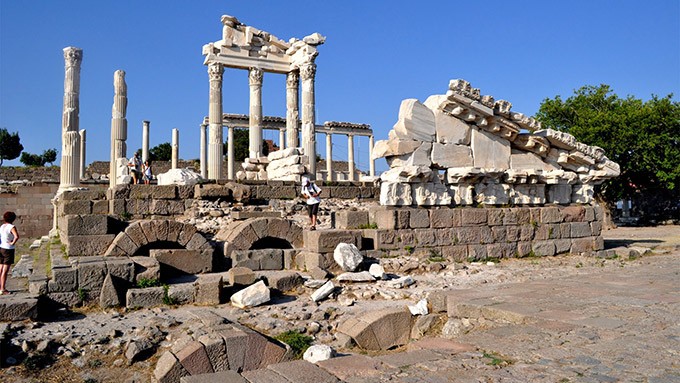
Pergamon, an ancient Greek city situated near the Caicus River, is located 26 km away from the Aegean Sea and 85 km from Izmir. During the Hellenistic period, Pergamon served as the capital of the Kingdom of Pergamon. In 281 BC, Philataerus, a successor of Alexander the Great, took control of the city after Lysimachus was defeated by Seleucus of Syria. Later, Philataerus’s nephew, Eumenes, declared Pergamon’s independence. The rulers of Pergamon, including Philataerus and his successors, formed an alliance with the Roman Empire against Philip V of Macedonia.
Under the rule of the Attalid dynasty, Pergamon experienced significant development. Magnificent temples, roads, and even a library, rivaling Alexander’s Library in Egypt, were constructed. The Attalids also established the Asclepion, a center for medical education, healing, and spa treatments.
The Attalids supported the growth of neighboring towns by sending skilled artisans and granting them tax exemptions. They also made generous gifts to cultural sites such as Delphi, Delos, and Athens. Pergamon’s prosperity was derived from agriculture and the exploitation of silver mines. The people of Pergamon built numerous temples dedicated to Athena, and their prosperity eventually posed a threat to Rome.
In 133 BC, with the death of Attalus III and his lack of heirs, he bequeathed his kingdom to Rome. Initially, Rome was hesitant to claim Pergamon. Aristonicus, claiming to be the son of Eumenes II, led a rebellion of the impoverished against Rome. Although Aristonicus fought valiantly and Pergamon briefly gained its freedom, it never truly escaped Roman influence after the death of Attalus III.
Due to its distinct Hellenistic culture, Pergamon exerted a strong influence on Rome, which sought to emulate it. Eventually, Pergamon became the capital of the East for the Imperial Cult, where the worship of Zeus and Asclepius flourished. In 29 BC, Augustus allowed the construction of a grand temple dedicated to Zeus, the remains of which are now displayed at the Pergamon Museum in Berlin.
During the reigns of Hadrian and Trajan, Pergamon received contributions for the renovation of temples honoring them. Consequently, Pergamon flourished as a prosperous and beautiful city.
Pergamon is also recognized as one of the Seven Churches of Revelation. According to the Book of Revelation, Pergamon was considered the dwelling place of Satan and the location of his throne, possibly referring to the Altar of Zeus.
Today, many remnants of Pergamon can still be seen. The Upper Acropolis features a Hellenistic Theater, the Sanctuary of Trajan, the Sanctuary of Athena, the Library (Athenaeum), Royal Palaces, the Heroon (a shrine where the kings of Pergamon worshipped), the Temple of Dionysus, the Upper Agora, Roman Baths, Diodorus Pasporos Heroon, and Arsenals. The Library of Pergamon was the second most renowned library in ancient Greek civilization, housing over 200,000 books. It is believed that Marc Anthony presented this library to Cleopatra as a wedding gift.
The Lower Acropolis includes the Upper Gymnasium, Middle Gymnasium, Lower Gymnasium, the Temple of Demeter, the Sanctuary of Hera, the House of Attalus, the Lower Agora, and the Gate of Eumenes.
At the foot of the acropolis lies the Asclepion, also known as the sanctuary of Asclepius, the god of healing. Visitors would walk along an 820-meter-long colonnaded sacred way to reach the Asclepion. It served as a spa and medical center where patients could bathe in sacred waters and seek healing through the power of music and water. Doctors would interpret the patients’ dreams, as it was believed that Asclepius would appear in their dreams to provide healing. The site features a Roman Theater, the North Stoa, the South Stoa, the Temple of Asclepius, a circular treatment center, a healing spring, an underground passageway, a library, the Via Tecta (the sacred way), and a Propylon.
The Serapis Temple, also known as the temple of the Egyptian god Isis or Serapis, is now referred to as the Red Basilica. In the 1st century AD, it was converted into a Christian church. The Red Basilica, or Church of Pergamon, is one of the seven churches mentioned in the Book of Revelations.




